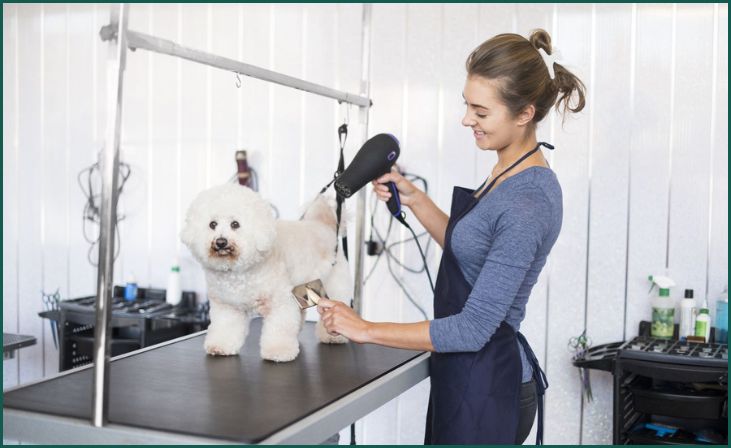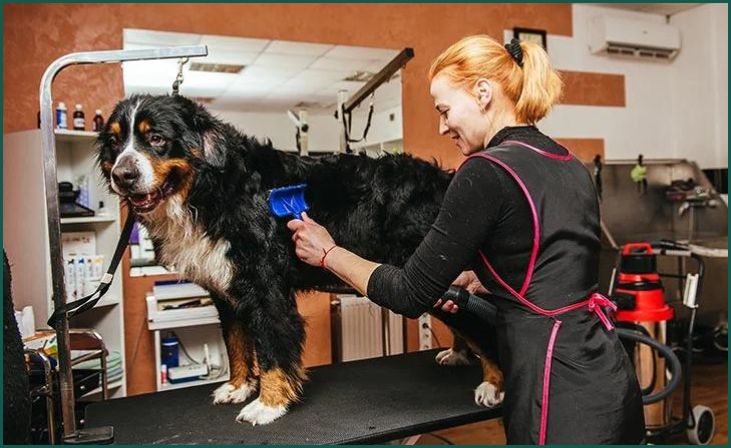Grooming your pet at home goes beyond being a mere task; it transforms into a meaningful bonding experience that significantly contributes to the overall well-being of your furry friend. Within the realms of this guide, we embark on a comprehensive exploration of the intricacies involved in pet grooming. Our aim is to furnish you with invaluable insights and practical tips, ensuring that the grooming process becomes not just a routine, but a genuinely enjoyable activity for both you and your beloved pet. In the journey of grooming, we delve into the nuanced aspects that make this experience special.
Table of Contents
ToggleHow To Groom Your Pet At Home?
1. Prepare Your Workspace

Creating a comfortable and well-organized grooming space is essential for a successful home grooming session. Choose a quiet and well-lit area where your pet can relax. Lay out all the necessary grooming tools, such as brushes, combs, nail clippers, and towels. This helps streamline the process, ensuring that you have everything you need within reach. By having a designated grooming space, your pet will associate the area with the grooming routine, making future sessions more manageable.
Also Read:- Top Small Pet Birds For Kids
2. Brushing
Brushing is a crucial step in the grooming process, promoting a healthy coat and minimizing shedding. Begin by selecting the appropriate brush for your pet’s coat type. Slicker brushes work well for long-haired breeds, while bristle brushes are suitable for short-haired ones. Brush in the direction of hair growth to prevent discomfort and remove tangles or mats gently. Regular brushing not only maintains the coat’s health but also serves as a bonding activity between you and your pet, fostering a positive relationship.
3. Bathing
When it’s time for a bath, ensure you use a pet-friendly shampoo. Fill a basin with warm water and gently wet your pet’s fur, avoiding the eyes and ears. Apply the shampoo, creating a lather, and then rinse thoroughly. Towel-dry your pet or use a pet-friendly hairdryer on a low setting. Bathing frequency depends on your pet’s breed and lifestyle, so consult with your veterinarian for personalized advice. A clean and fresh-smelling pet not only feels good but contributes to a healthier living environment for both your pet and your family.
4. Nail Trimming
Nail trimming is a crucial aspect of pet grooming that, when done regularly, helps prevent discomfort and potential health issues. Use pet nail clippers to trim the tips of your pet’s nails, avoiding the quick, which contains blood vessels and nerves. If your pet has clear nails, the quick is visible as a pinkish area. For pets with dark nails, trim small amounts at a time to prevent accidental cutting into the quick. If you’re unsure or uncomfortable trimming your pet’s nails, seek guidance from your veterinarian or a professional groomer. Regular nail maintenance contributes to your pet’s overall comfort and well-being.
5. Ear Cleaning

Regular ear cleaning is essential to prevent ear infections and maintain your pet’s ear health. Inspect your pet’s ears for any signs of redness, swelling, or discharge. Gently clean the ears using a damp cotton ball or a pet-specific ear cleaning solution. Avoid inserting anything into the ear canal, as this can lead to injury. If you notice persistent issues or your pet displays discomfort during ear cleaning, consult with your veterinarian. Clean ears contribute to your pet’s overall comfort and reduce the risk of ear-related health issues.
Don't just scroll, subscribe!
BuzzTrail's unique web-stories are the cure for boredom you've been waiting for.
6. Teeth Cleaning
Dental health is a crucial aspect of overall well-being for pets. Regular teeth cleaning helps prevent dental issues such as gum disease and tooth decay. Use a pet toothbrush and toothpaste to brush your pet’s teeth. Introduce dental care gradually, allowing your pet to become accustomed to the process. Focus on the outer surfaces of the teeth, and be gentle to avoid causing stress. If your pet resists tooth brushing, consider alternative dental care options, such as dental chews or toys. Consult with your veterinarian for recommendations on maintaining your pet’s dental health and schedule regular dental check-ups.
7. Trimming Hair (if necessary)
Certain breeds require hair trimming around specific areas such as the eyes, paws, or ears. Use pet grooming scissors or clippers with guards to trim hair carefully. Prioritize safety by using tools designed for pets and taking your time to avoid accidental cuts. If you’re unsure about the trimming process, seek guidance from a professional groomer. Regular hair trimming enhances your pet’s overall appearance, prevents matting, and ensures that they are comfortable and free from hair-related issues.
8. Reward Your Pet
It is essential to provide your pet with positive reinforcement throughout the grooming process in order to establish a positive association with the grooming process. In order to show appreciation for your pet’s cooperation, you should reward them with treats, praise, and gentle strokes. Additionally, the bond between you and your furry companion is strengthened as a result of this positive reinforcement, which not only makes the grooming experience more enjoyable for your pet. Positive reinforcement that is consistent helps to build trust, which in turn makes future grooming sessions less stressful and more fun.
9. Regular Maintenance
Establishing a grooming routine based on your pet’s specific needs is crucial for their overall health and well-being. Regular grooming sessions help prevent matting, reduce shedding, and allow you to identify any potential health issues early on. The frequency of grooming depends on factors such as your pet’s breed, coat type, and lifestyle. Consult with your veterinarian to determine the ideal grooming schedule for your pet. Consistent and routine maintenance contributes to a happy, healthy, and well-groomed pet.
Also Read:- Most Popular Horse Breeds
10. Professional Help

If you encounter difficulties during the grooming process or your pet has specific grooming needs, don’t hesitate to seek professional help. Professional groomers have the expertise and experience to handle various breeds and ensure a stress-free grooming experience for your pet. They can provide specific services such as breed-specific regular haircuts, specialized grooming techniques, and additional pampering. Professional grooming is especially beneficial for pets with intricate coat patterns or those requiring specific attention to detail. Consider professional grooming as an investment in your pet’s overall well-being, ensuring they receive the best care possible.
Conclusion
Engaging in grooming your pet at home unfolds as a truly rewarding experience that goes beyond the mere physical care of your furry companion. It becomes a journey of mutual understanding, trust, and affection, strengthening the unique bond between you and your four-legged friend. This shared activity transcends the routine of maintenance; it transforms into a heartfelt connection that contributes significantly to your beloved pet’s overall well-being and happiness.
FAQs
Can I use human shampoo on my pet?
Can I use human shampoo on my pet?
Using human shampoo may harm your pet’s skin. Opt for pet-friendly shampoos specifically formulated for their needs.
How often should I groom my pet?
How often should I groom my pet?
Grooming frequency varies based on breed and individual needs. Generally, a weekly grooming session is beneficial.

